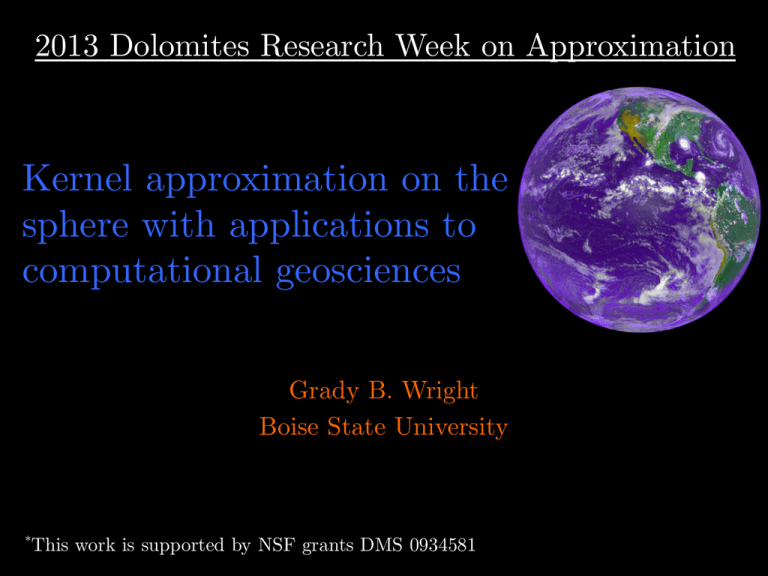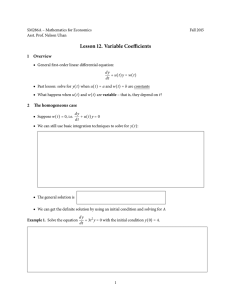Kernel approximation on the sphere with applications to computational geosciences
advertisement

2013 Dolomites Research Week on Approximation Kernel approximation on the sphere with applications to computational geosciences Grady B. Wright Boise State University *This work is supported by NSF grants DMS 0934581 2013 Dolomites Research Week on Approximation Lecture 1: Introduction to kernels and approximation on the sphere Grady B. Wright Boise State University *This work is supported by NSF grants DMS 0934581 Overview ● Applications in spherical geometries ● Scattered data interpolation in ● Positive definite radial kernels: radial basis functions (RBF) ● Some theory ● Scattered data interpolation on the sphere ● Positive definite (PD) zonal kernels ● Brief review of spherical harmonics ● Characterization of PD zonal kernels ● Conditionally positive definite zonal kernels ● Examples ● Error estimates: ● Reproducing kernel Hilbert spaces ● Sobolev spaces ● Native spaces ● Geometric properties of node sets ● Optimal nodes on the sphere DRWA 2013 Lecture 1 Where I am from DRWA 2013 Lecture 1 Where I am from DRWA 2013 Lecture 1 Where I am from DRWA 2013 Lecture 1 Where I am from DRWA 2013 Lecture 1 Where I am from DRWA 2013 Lecture 1 Where I am from DRWA 2013 Lecture 1 Where I am from DRWA 2013 Lecture 1 Where I am from DRWA 2013 Lecture 1 Where I am from DRWA 2013 Lecture 1 Where I am from DRWA 2013 Lecture 1 Where I am from DRWA 2013 Lecture 1 Where I am from DRWA 2013 Lecture 1 Where I am from DRWA 2013 Lecture 1 Where I am from DRWA 2013 Lecture 1 Applications in spherical geometries ● A visual overview: applications in the geosciences Shallow water flows: numerical weather prediction Rayleigh-Bénard Convection: Mantle convection Vector fields on the sphere Numerical integration DRWA 2013 Lecture 1 Interpolation with kernels Examples: DRWA 2013 Lecture 1 Interpolation with kernels Examples: DRWA 2013 Lecture 1 Interpolation with kernels DRWA 2013 Lecture 1 Interpolation with kernels The image cannot be displayed. Your computer may not have enough memory to open the image, or the image may have been corrupted. Restart your computer, and then open the file again. If the red x still appears, you may have to delete the image and then insert it again. The image cannot be displayed. Your computer may not have enough memory to open the image, or the image may have been corrupted. Restart your computer, and then open the file again. If the red x still appears, you may have to delete the image and then insert it again. The image cannot be displayed. Your computer may not have enough memory to open the image, or the image may have been corrupted. Restart your computer, and then open the file again. If the red x still appears, you may have to delete the image and then insert it again. DRWA 2013 Lecture 1 Radial basis function (RBF) interpolation Key idea: linear combination of translates and rotations of a single radial kernel: DRWA 2013 Lecture 1 Radial basis function (RBF) interpolation Key idea: linear combination of translates and rotations of a single radial kernel: DRWA 2013 Lecture 1 Radial basis function (RBF) interpolation Key idea: linear combination of translates and rotations of a single radial kernel: DRWA 2013 Lecture 1 Radial basis function (RBF) interpolation Key idea: linear combination of translates and rotations of a single radial kernel: DRWA 2013 Lecture 1 Radial basis function (RBF) interpolation Key idea: linear combination of translates and rotations of a single radial kernel: DRWA 2013 Lecture 1 Radial basis function (RBF) interpolation Key idea: linear combination of translates and rotations of a single radial kernel: DRWA 2013 Lecture 1 Radial basis function (RBF) interpolation Key idea: linear combination of translates and rotations of a single radial kernel: Linear system for determining the interpolation coefficients DRWA 2013 Lecture 1 Positive definite radial kernels • Some results on positive definite radial kernels. DRWA 2013 Lecture 1 Positive definite radial kernels • Some results on positive definite radial kernels. DRWA 2013 Lecture 1 Positive definite radial kernels • Some results on positive definite radial kernels. DRWA 2013 Lecture 1 Positive definite radial kernels • Some results on positive definite radial kernels. DRWA 2013 Lecture 1 Positive definite radial kernels • Some results on positive definite radial kernels. DRWA 2013 Lecture 1 Positive definite radial kernels DRWA 2013 Lecture 1 • Some results on positive definite radial kernels. Examples: Gaussian (r) = exp( ("r)2 ) Inverse multiquadric Inverse quadratic Positive definite radial kernels ● Results on dimensions specific positive definite radial kernels: DRWA 2013 Lecture 1 Positive definite radial kernels ● Examples Finite-smoothness Matérn Truncated powers Wendland (1995) DRWA 2013 Lecture 1 Infinite-smoothness J-Bessel Platte Conditionally positive definite kernels DRWA 2013 Lecture 1 ● Discussion thus far does not cover many important radial kernels: Cubic Thin plate spline Cubic spline in 1-D Generalization of energy minimizing spline in 2D Multiquadric Popular kernel and first used in any RBF application; Hardy 1971 ● These can covered under the theory of conditionally positive definite kernels. ● CPD kernels can be characterized similar to PD kernels but, using generalized Fourier transforms. We will not take this approach; see Ch. 8 Wendland 2005 for details. ● We will instead use a generalization of completely monotone functions. Conditionally positive definite kernels DRWA 2013 Lecture 1 Conditionally positive definite kernels DRWA 2013 Lecture 1 Conditionally positive definite kernels k=1 k=2 DRWA 2013 Lecture 1 Conditionally positive definite kernels k=1 k=2 DRWA 2013 Lecture 1 Conditionally positive definite kernels DRWA 2013 Lecture 1 Conditionally positive definite kernels DRWA 2013 Lecture 1 Conditionally positive definite kernels DRWA 2013 Lecture 1 Conditionally positive definite kernels DRWA 2013 Lecture 1 Radial basis function (RBF) interpolation DRWA 2013 Lecture 1 ● Many good books to consult further on RBF theory and applications: 1999 2005 2003 2007 2004 2014: SIAM A Primer on Radial Basis Functions with Applications to the Geosciences Bengt Fornberg Natasha Flyer Interpolation with kernels (revisited) DRWA 2013 Lecture 1 Interpolation with kernels on the sphere DRWA 2013 Lecture 1 SBF interpolation Key idea: linear combination of translates and rotations of a single zonal kernel on DRWA 2013 Lecture 1 SBF interpolation Key idea: linear combination of translates and rotations of a single zonal kernel on DRWA 2013 Lecture 1 SBF interpolation Key idea: linear combination of translates and rotations of a single zonal kernel on DRWA 2013 Lecture 1 SBF interpolation Key idea: linear combination of translates and rotations of a single zonal kernel on DRWA 2013 Lecture 1 SBF interpolation Key idea: linear combination of translates and rotations of a single zonal kernel on DRWA 2013 Lecture 1 SBF interpolation Key idea: linear combination of translates and rotations of a single zonal kernel on DRWA 2013 Lecture 1 SBF interpolation Key idea: linear combination of translates and rotations of a single zonal kernel on Linear system for determining the interpolation coefficients DRWA 2013 Lecture 1 Positive definite zonal kernels DRWA 2013 Lecture 1 Positive definite zonal kernels DRWA 2013 Lecture 1 Positive definite zonal kernels DRWA 2013 Lecture 1 Positive definite zonal kernels DRWA 2013 Lecture 1 Positive definite zonal kernels DRWA 2013 Lecture 1 Positive definite zonal kernels ● Some references for the material to come: DRWA 2013 Lecture 1 Spherical harmonics DRWA 2013 Lecture 1 ● A good understanding of functions on the sphere requires one to be wellversed in spherical harmonics. ● Spherical harmonics are the analog of 1-D Fourier series for approximation on spheres of dimension 2 and higher. ● Several ways to introduce spherical harmonics (Freeden & Schreiner 2008) ● We will use the eigenfunction approach and restrict our attention to the 2sphere. ● Following this we review some important results about spherical harmonics. Overview of spherical harmonics DRWA 2013 Lecture 1 Overview of spherical harmonics DRWA 2013 Lecture 1 Overview of spherical harmonics DRWA 2013 Lecture 1 Overview of spherical harmonics DRWA 2013 Lecture 1 Overview of spherical harmonics DRWA 2013 Lecture 1 Overview of spherical harmonics m=-3 m=-2 m=-1 m=0 m=1 DRWA 2013 Lecture 1 m=2 m=3 Overview of spherical harmonics m=-4 m=-3 m=-2 m=-1 m=0 m=1 DRWA 2013 Lecture 1 m=2 m=3 m=4 Overview of spherical harmonics DRWA 2013 Lecture 1 Overview of spherical harmonics DRWA 2013 Lecture 1 Theorems for positive definite zonal kernels DRWA 2013 Lecture 1 Theorems for positive definite zonal kernels DRWA 2013 Lecture 1 Theorems for positive definite zonal kernels DRWA 2013 Lecture 1 Conditionally positive definite zonal kernels DRWA 2013 Lecture 1 Conditionally positive definite zonal kernels DRWA 2013 Lecture 1 Conditionally positive definite zonal kernels DRWA 2013 Lecture 1 Spherical Fourier coefficients DRWA 2013 Lecture 1 Examples of positive definite zonal kernels DRWA 2013 Lecture 1 Error estimates DRWA 2013 Lecture 1 Reproducing kernel Hilbert spaces DRWA 2013 Lecture 1 Reproducing kernel Hilbert spaces DRWA 2013 Lecture 1 Reproducing kernel Hilbert spaces DRWA 2013 Lecture 1 Reproducing kernel Hilbert spaces DRWA 2013 Lecture 1 Sobolev spaces DRWA 2013 Lecture 1 Sobolev spaces DRWA 2013 Lecture 1 Native spaces DRWA 2013 Lecture 1 Native spaces DRWA 2013 Lecture 1 Native spaces DRWA 2013 Lecture 1 Native spaces DRWA 2013 Lecture 1 Geometric properties of node sets DRWA 2013 Lecture 1 ● The following properties for node sets on the sphere appear in the error estimates: (Only part of the sphere is shown) Interpolation error estimates ● We start with known error estimates for kernels of finite smoothness. Notation: Theorem. Target functions in the native space. DRWA 2013 Lecture 1 Interpolation error estimates DRWA 2013 Lecture 1 ● We start with known error estimates for kernels of finite smoothness. Notation: Theorem. Target functions twice as smooth as the native space. Remark. Known as the “doubling trick” from spline theory. (Schaback 1999) Interpolation error estimates DRWA 2013 Lecture 1 ● We start with known error estimates for kernels of finite smoothness. Notation: Theorem. Target functions rougher than the native space. Remark. (1) Referred to as “escaping the native space”. (2) These rates are the best possible. (Narcowich, Ward, & Wendland (2005, 2006). Interpolation error estimates ● Error estimates for infinitely smooth kernels DRWA 2013 Lecture 1 (e.g. Gaussian, multiquadric). Notation: Theorem. Target functions in the native space. Remarks: (1) (2) (3) (4) This is called spectral (or exponential) convergence. Function space may be small, but does include all band-limited functions. Only known result I am aware of (too bad there are not more). Numerical results indicate convergence is also fine for less smooth functions. Optimal nodes DRWA 2013 Lecture 1 ● If one has the freedom to choose the nodes, then the error estimates indicate they should be roughly as evenly spaced as possible. Icosahedral Fibonacci Equal area Deterministic Examples: Swinbank & Purser (2006) Minimum energy, s=3 Maximal determinant Non-deterministic Minimum energy s=2 Saff & Kuijlaars (1997) Hardin & Saff (2004) Womersley & Sloan (2001) Concluding remarks DRWA 2013 Lecture 1 ● This was general background material for getting started in this area. ● There is still much more to learn and many interesting problems. ● Remainder of the lectures will focus on: o Approximation (and decomposition) of vector fields. o Better bases for certain kernels (better=more stable). o Fast algorithms for interpolation (with applications to quadrature) o Numerical solution of partial differential equations on spheres. ² Focus: non-linear hyperbolic equations. ² Global and local methods. o Problems in spherical shells. ² Mantle convection (Rayleigh-Bénard convection). ² Generalizations to other manifolds. v If you have any questions or want to chat about research ideas, please come and talk to me. Grazie per la vostra attenzione.






